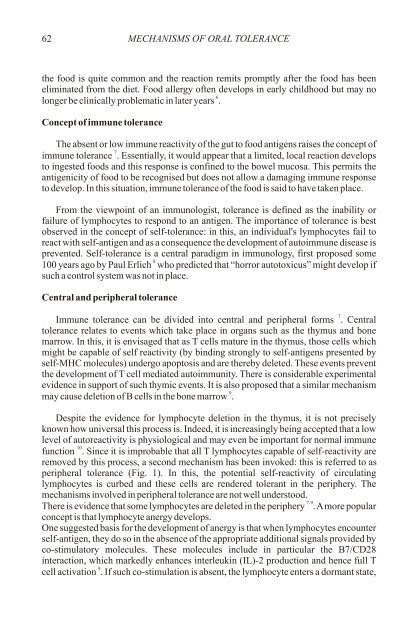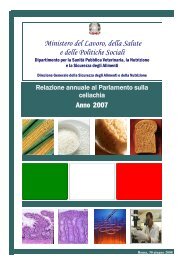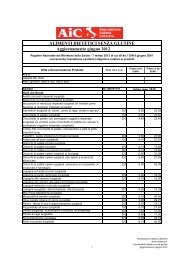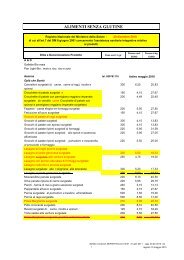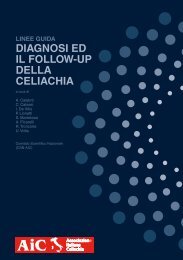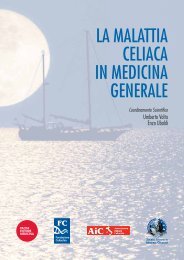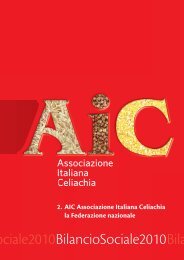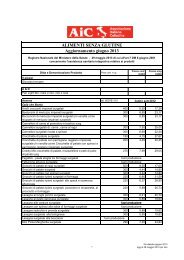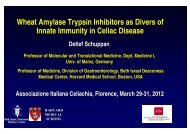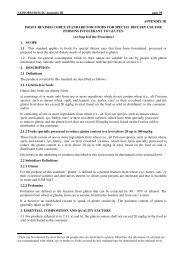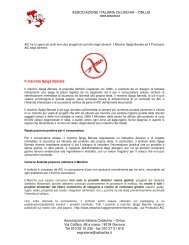primary prevention of coeliac disease - Associazione Italiana ...
primary prevention of coeliac disease - Associazione Italiana ...
primary prevention of coeliac disease - Associazione Italiana ...
Create successful ePaper yourself
Turn your PDF publications into a flip-book with our unique Google optimized e-Paper software.
62<br />
MECHANISMS OF ORAL TOLERANCE<br />
the food is quite common and the reaction remits promptly after the food has been<br />
eliminated from the diet. Food allergy <strong>of</strong>ten develops in early childhood but may no<br />
6<br />
longer be clinically problematic in later years .<br />
Concept <strong>of</strong> immune tolerance<br />
The absent or low immune reactivity <strong>of</strong> the gut to food antigens raises the concept <strong>of</strong><br />
7<br />
immune tolerance . Essentially, it would appear that a limited, local reaction develops<br />
to ingested foods and this response is confined to the bowel mucosa. This permits the<br />
antigenicity <strong>of</strong> food to be recognised but does not allow a damaging immune response<br />
to develop. In this situation, immune tolerance <strong>of</strong> the food is said to have taken place.<br />
From the viewpoint <strong>of</strong> an immunologist, tolerance is defined as the inability or<br />
failure <strong>of</strong> lymphocytes to respond to an antigen. The importance <strong>of</strong> tolerance is best<br />
observed in the concept <strong>of</strong> self-tolerance: in this, an individual's lymphocytes fail to<br />
react with self-antigen and as a consequence the development <strong>of</strong> autoimmune <strong>disease</strong> is<br />
prevented. Self-tolerance is a central paradigm in immunology, first proposed some<br />
8<br />
100 years ago by Paul Erlich who predicted that “horror autotoxicus” might develop if<br />
such a control system was not in place.<br />
Central and peripheral tolerance<br />
7<br />
Immune tolerance can be divided into central and peripheral forms . Central<br />
tolerance relates to events which take place in organs such as the thymus and bone<br />
marrow. In this, it is envisaged that as T cells mature in the thymus, those cells which<br />
might be capable <strong>of</strong> self reactivity (by binding strongly to self-antigens presented by<br />
self-MHC molecules) undergo apoptosis and are thereby deleted. These events prevent<br />
the development <strong>of</strong> T cell mediated autoimmunity. There is considerable experimental<br />
evidence in support <strong>of</strong> such thymic events. It is also proposed that a similar mechanism<br />
9<br />
may cause deletion <strong>of</strong> B cells in the bone marrow .<br />
Despite the evidence for lymphocyte deletion in the thymus, it is not precisely<br />
known how universal this process is. Indeed, it is increasingly being accepted that a low<br />
level <strong>of</strong> autoreactivity is physiological and may even be important for normal immune<br />
10<br />
function . Since it is improbable that all T lymphocytes capable <strong>of</strong> self-reactivity are<br />
removed by this process, a second mechanism has been invoked: this is referred to as<br />
peripheral tolerance (Fig. 1). In this, the potential self-reactivity <strong>of</strong> circulating<br />
lymphocytes is curbed and these cells are rendered tolerant in the periphery. The<br />
mechanisms involved in peripheral tolerance are not well understood.<br />
7-9<br />
There is evidence that some lymphocytes are deleted in the periphery . A more popular<br />
concept is that lymphocyte anergy develops.<br />
One suggested basis for the development <strong>of</strong> anergy is that when lymphocytes encounter<br />
self-antigen, they do so in the absence <strong>of</strong> the appropriate additional signals provided by<br />
co-stimulatory molecules. These molecules include in particular the B7/CD28<br />
interaction, which markedly enhances interleukin (IL)-2 production and hence full T<br />
9<br />
cell activation . If such co-stimulation is absent, the lymphocyte enters a dormant state,


